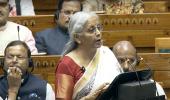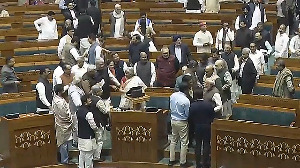Finance Minister Nirmala Sitharaman on Saturday announced significant income tax cuts for the middle class and unveiled a blueprint for next generation reforms as she looked to shore up a slowing economy amid global uncertainties.

Individuals earning up to Rs 12.75 lakh in a year will not have to pay any taxes after she raised the exemption threshold from Rs 7 lakh.
She also altered tax slabs for people earning above this threshold to help save up to Rs 1.1 lakh in taxes for those with income up to Rs 25 lakh in a year.
The tax cuts, which will cost the exchequer about Rs 1 lakh crore, will benefit 6.3 crore people, or more than 80 per cent of taxpayers, who earn up to Rs 12 lakh a year.
"The new structure will substantially reduce taxes on the middle class and leave more money in their hands, boosting household consumption, savings and investment," Sitharaman said presenting what was dubbed as 'reformist' budget for the next fiscal in Lok Sabha.
The Budget for April 2025 to March 2026 fiscal (FY26) proposed to raise foreign investment limit in insurance sector to 100 per cent from current 74 per cent and continued spending spree on infrastructure while raising allocations for social sectors as well as providing for measures for poor, youth, farmers and women.
All this she did while managing to stick to the fiscal consolidation roadmap, projecting a fiscal deficit of 4.4 per cent of the GDP in FY26 as against an estimated 4.8 per cent in the current year ending March 31.
Also announced were duty cuts on intermediaries and certain life saving drugs.
To balance the revenue lost, she budgeted a modest increase in capital spending at Rs 11.21 lakh crore in the next financial year compared to a lowered Rs 10.18 lakh crore in current fiscal. Besides, an increase in dividend expected from the Reserve Bank and other government-owned financial institutions will also help to contain the losses.
The budget comes against the backdrop of the Indian economy growing at its weakest pace since pandemic and rising geopolitical risks particularly with the new US President Donald Trump threatening to impose widespread tariffs including on India.
The 6.4 per cent GDP growth estimated for the current fiscal and 6.3 to 6.8 per cent in the next are well below the 8 per cent growth needed to meet the ambitious goal of making India a developed nation by 2047.
"Our endeavour will be to keep the fiscal deficit each year such that the central government debt remains on a declining path as a percentage of the GDP," she said, projecting debt at 50 per cent of GDP by March 2031.
Other measures include a national mission to push high-yielding crops with a special focus on pulses and cotton production, hike in the limit of subsidised credit to farmers to Rs 5 lakh from Rs 3 lakh, missions to push manufacturing and exports, a new policy for labour intensive sectors like leather and footwear and a scheme to make India a global hub for toy manufacturing.
The finance minister also announced a social security cover for nearly 1 crore gig workers and a Rs 10,000 crore fund of funds for startups.
Another major announcement was setting a target of at least 100 gigawatt of electricity from nuclear energy by 2047 and amendment to nuclear liability regulations to allow private sector investment.
Sitharaman also announced reduction in duties on a raft of goods including open cells, while fully exempting critical minerals such as cobalt, scraps of lithium-ion battery, lead, zinc and a few others from import duty.
Commenting on the Budget, Christian de Guzman, Senior Vice President, Moody's Ratings, said: "As the government unveiled its budget for 2025-26 amid a somewhat dampened macroeconomic backdrop as compared to recent years, it has had to slow the pace of fiscal consolidation to provide firmer support to growth."
"In particular, announced tax relief measures have constrained the growth of revenue receipts, which will rise at its slowest pace since 2022-23; as such, falling expenditure as a share of GDP has borne the brunt of the projected narrowing of the fiscal deficit even as the emphasis on capital expenditure has been sustained," he said.
"Although the Union government remains on track to meet its near-term policy goals, we do not expect a sufficient improvement in the debt burden, or the proportion of the budget earmarked for debt servicing to change our broader assessment that India's fiscal strength will remain weaker than most of its investment-grade peers," he added.











 © 2025
© 2025